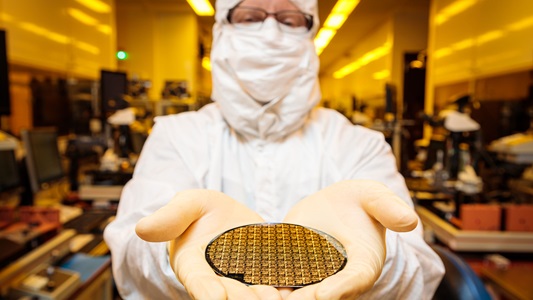At the microelectronics foundry, engineers hover over wafers that enable a range of missions, from advanced satellite communications to complex astrophysics systems.
Faster, Smaller, Greater: Transforming Microelectronics
By Cassie Mann and Michelle A. Monroe
From the spacecraft that took humankind to the moon to the cellphone in your pocket, Northrop Grumman has always been a trailblazer in microelectronics, the tiny parts that power electronic devices. In foundries on both coasts of the United States, Northrop Grumman engineers, technicians and researchers design and manufacture complex microelectronics components, and the company’s expertise in microelectronics continues to shape the world — as it has for nearly seven decades.
Microchips to Moonscapes
The story of microelectronics starts with the bulky and, by today’s standards, slow transistors of the 1950s. Transistors are a type of semiconductor device, a crucial component in electronic circuits used to amplify or switch the electrical currents that power most electronic devices.
Simon Ramo — co-founder of TRW, one of Northrop Grumman’s legacy companies — recognized the potential of microelectronics, including transistors, to revolutionize the space and missile industry and, in 1964, established a microelectronics department at the company’s Space Park site in Redondo Beach, California. It was there that, in the early 1960s, TRW invented transistor-transistor logic, a foundational logic family which powered the computers of the day and for the next generation. The first computers used enormous transistors, part of the reason early computers occupied entire rooms and required a lot of power.
Around the same time, on the other side of the country, a small group of Westinghouse Electric Corporation engineers in Linthicum, Maryland, and Pittsburgh, Pennsylvania, were also making semiconductor devices. Westinghouse Electric Corporation, another of Northrop Grumman’s legacy companies, established its Advanced Technologies Laboratory (ATL) facility in 1969.
As transistors downsized, they became faster and more power efficient. Multiple transistors could be integrated into a single piece of semiconductor to create integrated circuits, known today as microchips. One of ATL’s first major technological contributions was building more than half of the integrated circuits used on the Apollo program lunar camera, which transmitted Neil Armstrong’s first steps on the moon to televisions around the world — a contribution for which the company would, in 1970, be awarded an Emmy.
“It’s been pretty amazing to see the evolution of microchips,” said Northrop Grumman Fellow Aaron Oki. “It’s a fascinating technology area. There are always new capabilities and new things to learn about.”
True Pioneers
Microchips have come a long way since the Apollo program. The microchips that drive today’s missions can trace their origins to the 1980s, when Northrop Grumman developed new methods for designing, fabricating and testing microchips as part of a U.S. Defense Advanced Research Projects Agency program. The innovation achieved through this government-funded initiative impacted a wide range of microchip applications — from satellite communications to collision-avoidance systems — and enabled the company to establish a pilot line for commercial compound semiconductor microchip production.
Northrop Grumman collaborated with another company in the 1990s to further commercialize microchip technology, resulting in the development of amplifier circuits — components that boost signal strength — that made the widespread adoption of cellphones possible by enhancing battery life and reducing costs. A testament to the impact: if you had a cellphone in the early 2000s, it probably had microchips produced by Northrop Grumman.
Modern cellphone cameras also incorporate Northrop Grumman’s microchip technology. Patented in 1972 by a group of ATL engineers, the Correlated Double Sampling Video Imaging Technique enabled high-definition image capture and was originally developed for telecommunications modems. Now, this innovation is used in all cellphone cameras, as well as some types of televisions, medical imaging equipment and space telescopes, including the Hubble Telescope and the James Webb Space Telescope.
Preparing for the Missions of Tomorrow
Over the decades, Northrop Grumman’s microelectronics technologies have played — and continue to play — a critical national security role by supplying trusted microchips to defense programs and military systems. This constant reinvention has been thanks, in large part, to the company’s deep-rooted pioneering culture, said ATL Director Matt Hicks.
“Northrop Grumman and our microelectronics foundries have decades-long expertise in out-inventing ourselves, pushing the boundaries of what physics and chemistry allow for our next-generation systems,” said Matt.
In 2019, the company also expanded its physical microelectronics footprint, opening a microelectronics post-processing manufacturing facility in Apopka, Florida. The Apopka facility is focused on wafer bumping, the advanced packaging process that creates the metal solder bumps on the surface of semiconductor wafers that link the microchips to the circuit boards — improving performance, reducing size and making the overall product even more secure for the customer.
The team is now writing the next chapter in Northrop Grumman’s microelectronics journey. Earlier this year, the Northrop Grumman Microelectronics Center was established, bringing the company’s end-to-end microelectronics capabilities — from its foundries to its scientists and technicians — under one umbrella. This, along with the company’s legacy of microelectronics innovation, will power Northrop Grumman’s ability to meet mission needs on an accelerated timeline, said Rajinder Sandhu, a microelectronics program manager at Space Park.
“We’re showing the nation how Northrop Grumman’s disruptive technologies can be further amplified,” said Rajinder. “It’s more than just the technologies. It’s the people.”
* Rachael Tiehel contributed to this article.
Learn more about Northrop Grumman’s microelectronics leadership, or explore what life’s like working at Northrop Grumman.
Life at Northrop Grumman
Your work at Northrop Grumman makes a difference. Whether you want to design next-generation aircraft, harness digital technologies or build spacecraft that will return humanity to the moon, you’ll contribute to technology that’s transforming the world. Check out our career opportunities to see how you can help define possible.


